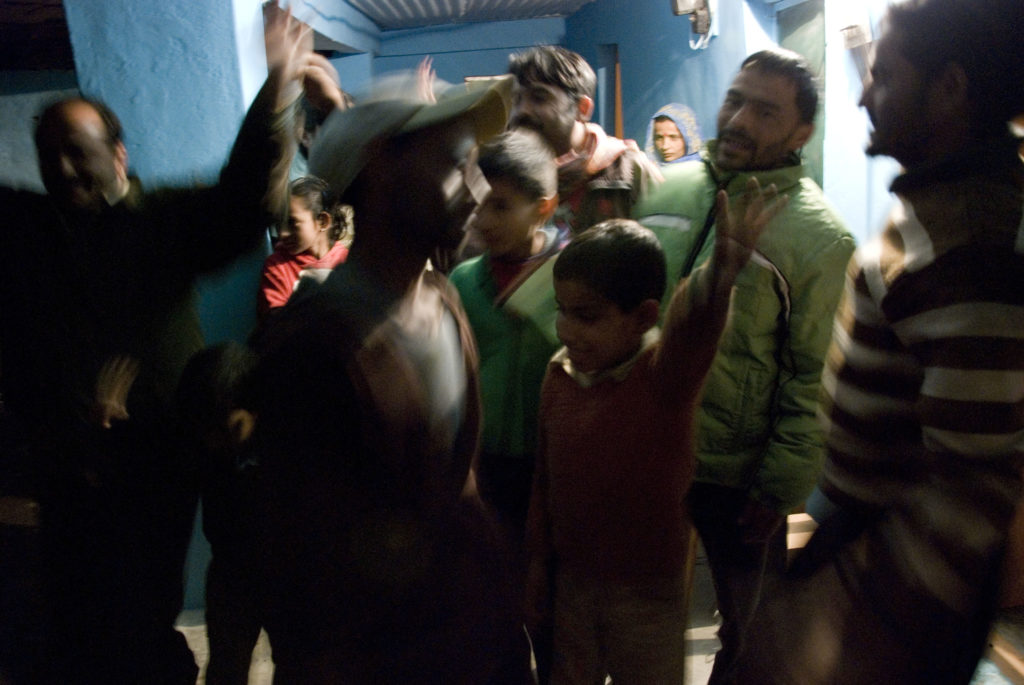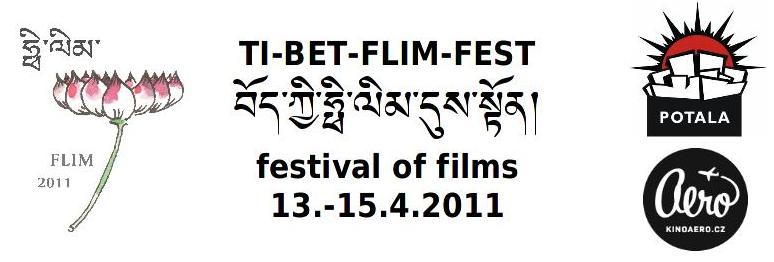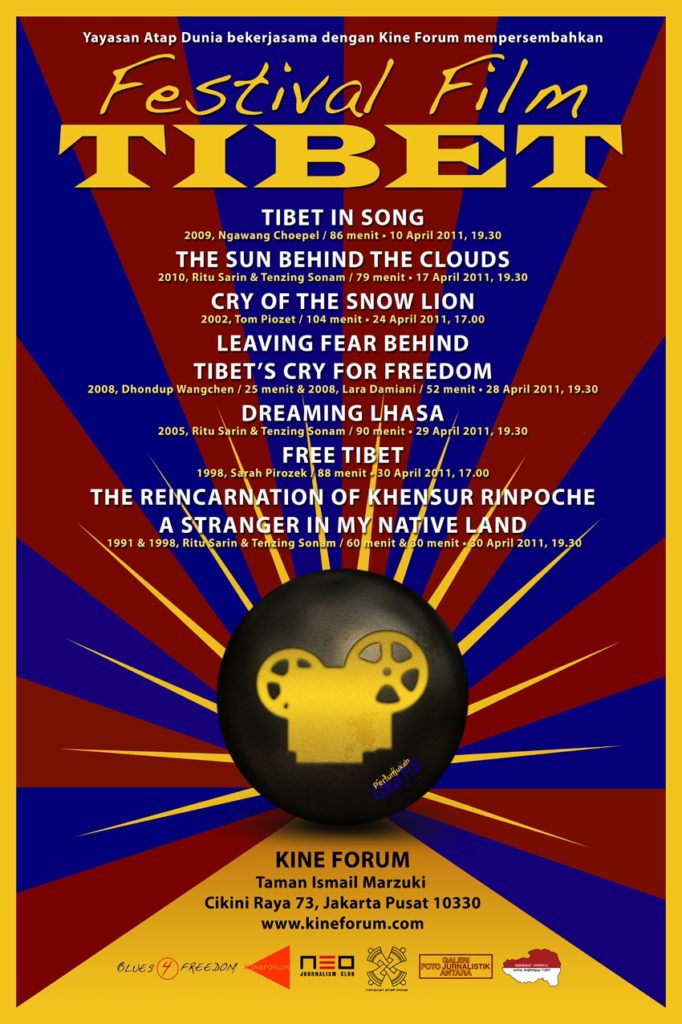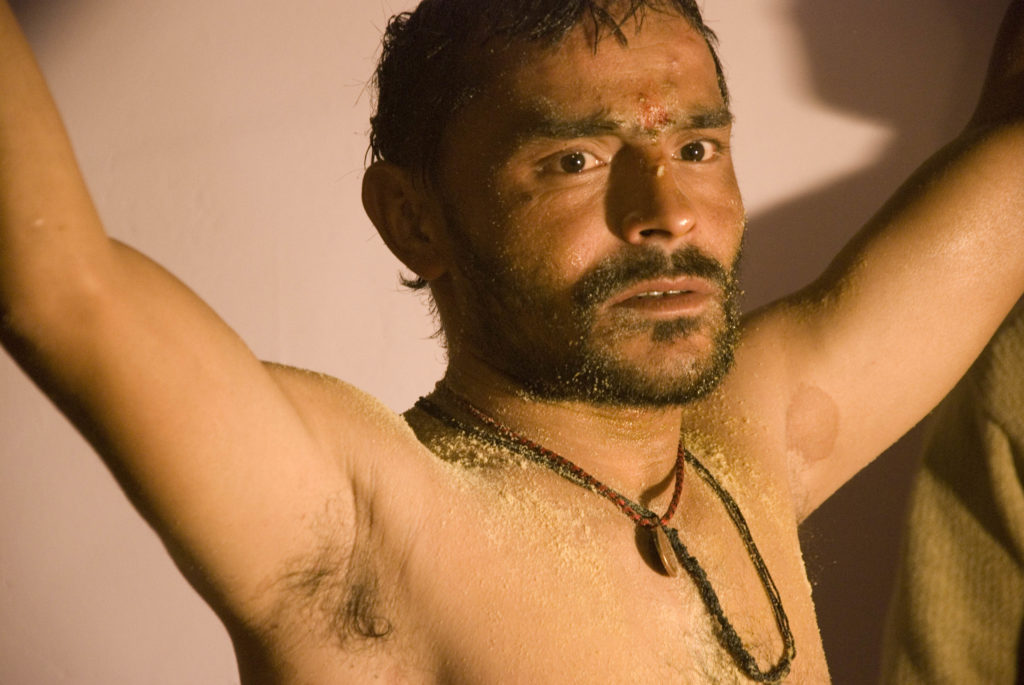In 1991, Ritu and I had the exceptional good fortune of being able to travel with the Dalai Lama as he visited the Soviet Buddhist regions of Buryatia, Kalmykia and Aginsky. Our job was to document this historic visit on video. We were part of a small and intimate entourage, crisscrossing the Soviet empire in Aeroflot’s no-frills, long distance Tupolevs and Ilyushins, and covering smaller distances by twin-rotored helicopters. The Soviet Union was fast unravelling, and the situation was desperate: we could tell by the on-board catering – a slice of bread and a chunk of dubious salami on an eight-hour flight. One consequence of the momentous events overtaking the country was the revival of religious practice after decades of suppression. Wherever the Dalai Lama went, he was greeted by masses of people, almost hysterical in their emotional welcome, desperate to receive teachings, and to rediscover their connection with their spiritual heritage. Incredibly, through all the years of darkness they had kept alive this link, tenuous, transformed and barely recognizable but still very much there. The Dalai Lama gave teachings and initiations, in stadiums and hippodromes, and the crowds came, eager for spiritual succour, happy just to see him and receive his blessings.

Among the Dalai Lama’s entourage was Telo Rinpoche, an 18-year-old lama from Drepung Monastery in South India. He was of Kalmyk origin, born in Philadephia and sent to India to become a monk at the age of six. The Dalai Lama later recognised him as the reincarnation of the famous Mongolian lama, Delowa Hutuktu (also known as Diluv Khutagt), who was himself the reincarnation of the great Indian master, Tilopa. I had heard about the Kalmyks before I actually went to their homeland. My family’s root lama, Zorgey Rinpoche, the reincarnation of my great-uncle, had been brought to Kumbum Monastery from Inner Mongolia and then sent to Drepung Monastery in Lhasa for further studies. He escaped to India soon after the Chinese invasion of 1950 and eventually made his way to New Jersey where he served a small émigré Kalmyk community as their resident lama. Delowa Hutuktu had also spent his final years among them. When I first went to America in 1979, Zorgey Rinpoche still maintained close ties with the American Kalmyks and I visited their temple in New Jersey and met several of its members. I also knew that a famous Kalmyk lama, Geshe Wangyal, had not only been instrumental in helping the CIA develop a Tibetan version of the Morse Code in the late 50s, but had also been the first important Tibetan Buddhist teacher in the West, the guru of such luminaries as Robert Thurman and Jeffrey Hopkins. But like most people who knew something about the Kalmyks, I thought they were Mongolians and had absolutely no idea of how fascinating their history was.
The first thing I realized as we flew south from Moscow to Elista, the capital of Kalmykia, was that it was at least a thousand miles from Mongolia. The Kalmyks were originally a Mongolian tribe from the southern steppes of Siberia, who migrated westwards in the 17th century and eventually settled around the mouth of the River Volga, on the shores of the Caspian Sea, in what was, and still is, European Russia. In return for guarding its southern flanks, the Kalmyks were incorporated into the Russian Empire as a Khanate and for over for two centuries, until the Second World War, they fulfilled their obligation, integrating effectively into the Tsar’s fighting forces. Like most Mongolians, the Kalmyks were staunch followers of Tibetan Buddhism and their presence in southern Russia created the unlikely scenario of a Buddhist republic in Europe. For two hundred years, until the advent of communism, Kalmyk monks kept alive their connection to Tibet by making the incredibly long and hazardous journey to Lhasa to study at one of its three great Gelugpa monasteries.

The establishment of the Soviet Union brought about unimaginable suffering on the Kalmyks. Stalin proscribed the practice of Buddhism in the early 1930s. As in Tibet some decades later, monks were killed, forcibly defrocked or sent to Siberia, and all of Kalmykia’s monasteries and temples were destroyed. During the Second World War, the Nazis briefly occupied Kamykia during their campaign in southern Russia, which culminated with their defeat at the battle of Stalingrad (now Volgograd) in 1943. Stalin immediately deported the entire Kalmyk population of about 100,000 in cattle trucks to Siberia as punishment for having ‘collaborated’ with the Nazis. Thousands perished during the journey. The remaining Kalmyks were scattered in small pockets across Siberia, with no link to their homeland, their religion, their traditions, or even to each other. When they were finally allowed to return to Kalmykia in 1957, their population had dwindled to about 60,000. In their absence, their homes had been taken over by Russians and other ethnic groups. By this time, the majority had almost forgotten its native language, lost touch with its traditions, and had no overt contact with Buddhism for nearly three decades. Nonetheless, their sense of identity as a people remained strong and they set about rebuilding their lives. The practice of Buddhism, though, was to remain underground for another thirty years. But when the Soviet Union began to collapse in the early 90s, the Kalmyks were ready to reclaim their heritage, and it was at this critical period that the Dalai Lama visited Kalmykia for the first time.
I remember vividly the fervour with which the Kalmyks greeted the Dalai Lama on his first visit. Wherever he went, people flung themselves at his feet, literally crying with happiness. Day after day, they packed the hippodrome in Elista to listen to his teachings, which were translated into Russian. How much they understood was hard to know, but at the end of the teachings, the crowd mobbed the stage, scrabbling to get some memento of his visit. They fought for the flowers that decorated the stage, and they grabbed at the precious pills that were distributed but when we interviewed some of them later, they asked us what they should do with them!
The young Telo Rinpoche’s appearance in Kalmykia in the company of the Dalai Lama galvanised the community. It was as if he was their Messiah, sent especially to help them in their hour of need. At the time, he was more Tibetan than anything else and Kalmykia was as alien a land to him as it was for me. The Kalmyks appealed to him to return and help them revive their religion and rebuild their temples. The next year found him back in Kalmykia, elevated to the position of Minister of Religion and given the title of Shadjin Lama, the head lama of the Kalmyks. We followed him soon after, commissioned by the BBC to make a film about him.

Russia in the immediate post Soviet-era was a grim and scary place. The Dalai Lama’s representative in Moscow, Nawang Rabgyal, had his office-cum-residence in a gigantic hotel complex where we were almost robbed in our room in the middle of the night. Elista, the capital of the Republic of Kalmykia, was an even sadder place, a provincial Soviet town of concrete blocks and nothing much else, set in the treeless steppes of southern Russia. Telo Rinpoche, then all of 20 years old, had a huge office in the Kalmyk White House, a personal interpreter and an official limousine. But his dreams of building a khurul – a Buddhist temple – were being stymied by an intractable and impenetrable Soviet-era bureaucracy, and exacerbated by a language barrier and a lack of understanding of the local culture. Even as we were shooting the film, he called it quits and left Kalmykia. That was how our film, later broadcast on the BBC as The Trials of Telo Rinpoche, ended.
Telo Rinpoche subsequently went through many ups and downs. He married a Tibetan, had a son, and settled in Boulder, Colorado. Over the years, we kept in touch with him, intermittently at first and then more regularly. The ghosts of his failed mission in Kalmykia continued to haunt him. The Dalai Lama told him to go back and finish what he had started. The people of Kalmykia were only too happy to have their beloved Shadjin Lama return and since the late 90s, he has been spending most of his time there. On our occasional meetings in India or the US, he told us of the progress he was making. He asked us to come back to Kalmykia to see for ourselves the changes that had taken place since our last visit. And so in June this year, at his invitation and after 18 years, we finally found ourselves back in Russia and Kalmykia.
Moscow was a changed city. What used to be a city of few cars – all Russian-made – and even fewer shops had been transformed into one gigantic traffic jam. The airport road, where earlier, unsuspecting cars were sometimes stopped and robbed, was now one unending stream of vehicles, with not a Russian car in sight. It took us two and a half hours to drive from Sheremetyevo airport to the centre of Moscow, the longest airport transfer ever. We had plenty of time to talk to our local liaison from the Save Tibet Foundation, Natasha, who had come to pick us up, and find out about the state of the country. The inordinately large number of BMWs and Mercedes Benzes that inched along beside us, their owners hidden behind smoked glass; the giant supermarkets and malls, including an Ikea and an Auchan that we crawled past; and the huge billboards flaunting the good life, were apparently deceptive. Russia was in the throes of a crisis where the rich were getting super-rich and the poor were being left to fend for themselves. A kind of mafia/crony coterie ruled the country with no larger vision beyond lining its pockets and keeping all criticism at check. And underneath the shiny gloss of the new city, darker forces were being unleashed, an ugly form of ultra-nationalism that targeted all non-Russians and increasingly exploded in unprovoked and random attacks on the city’s sizeable minority community.

Elista, too, seemed changed, at least on the surface; brighter, greener and more prosperous. Here, too, there were more cars on the road. Telo Rinpoche was busy with the Mongolian President’s visit when we arrived. Later, we were invited to a cultural show where troupes from both Kalmykia and Mongolia sang and danced in front of the dignitaries. The Kalmyk chairman spoke in Russian, his Mongolian counterpart in his native language. Very few Kalmyks still spoke their own language and perhaps this was a reminder to them of their roots. Later, we caught up with Telo Rinpoche at his home where we were staying. For the next three days, we chatted incessantly, catching up on his years in Kalmykia and talking about his plans for the future, which included, among other things, going to Mongolia more often to reconnect with his previous incarnation’s legacy.

We visited the first khurul that he had rebuilt in Elista. This was the same building whose model had stood on his desk at the White House all those years ago, mocking him as he struggled to make headway with its construction. We recalled the scene we had filmed where a young Rinpoche looked out, dejected and demoralised, over the proposed site of the khurul, a barren expanse of frozen steppe broken only by the silhouette of a non-functioning crane in the distance. But he had come back and finished it and for some years, it was Kalmykia’s main temple, before another, grander khurul superseded it. The new temple was closer to the centre of Elista. It was a massive structure, faintly remniscent, with its distinctive pagoda shaped roofs, of a traditional khurul, but resolutely modern in all other ways. It was ringed by a circle of statues representing the 18 arhats. There were tourists among the faithful, groups coming from as far away as Volgograd and Rostov. A Russian wedding party was there for a photo shoot. School children were being shepherded around in groups. A middle-aged lady knelt before Telo Rinpoche and offered him a scarf. An old lady reverentially held his hand and placed it on her head; he held her lovingly, speaking to her comfortingly in Russian. Among the many surprises we discovered was the fact that Rinpoche could now get around without an interpreter.

Inside, a massive statue of the Buddha Sakyamuni dominated the main assembly hall. Beautifully executed murals, painted mainly by Tibetan artists, covered the walls. There was a good-sized auditorium and a museum of Kalmyk history and culture in the basement, and upstairs – interestingly for me – consultation rooms where Kalmyks could meet their lamas, who were mostly Tibetan, on a one-on-one basis. This was an unusual, modern twist to a traditional form of spiritual counsel and one that, according to Rinpoche, was very popular with the locals. The supplicants came for all kinds of reasons, to request divinations on a variety of matters, to select auspicious dates, to perform miscellaneous rites, and often, to find a sympathetic ear to unburden their personal and domestic troubles and difficulties. This dual role as spiritual guide and personal counsellor was a demanding one, not something the lamas had been trained in, and Rinpoche advised them to take it on as another way of putting their Buddhist studies into practice.
The most impressive achievement of the khurul was that it provided an imposing physical symbol around which the Kalmyks could rebuild their fragile and often beleaguered sense of identity. Kalmyks were proud of their khurul and increasingly, those coming to find solace here were the younger generation. To me, Kalmykia’s regeneration of its faith and culture was a lesson in how difficult it is to crush a people’s spirit and efface its identity. It is an example that we Tibetans can learn from. In our haste to sound the alarm bells about the imminent disappearance of our national identity, we overlook the enduring and deep-rooted nature of our historical and cultural legacy.
Although Tibet has much in common with the suffering of Kalmykia, there are several major differences worth pointing out. Unlike Kalmykia, which came into existence only in the 17th century, and which became incorporated into the Russian Empire in the 18th, Tibet has a long history – Chinese claims notwithstanding – of having existed as an independent country and is one of Asia’s great civilizations. The Kalmyks were followers of Tibetan Buddhism and even though the language, rituals and customs of their religion were all imported from Tibet and, in many ways, alien to them, they managed to keep their faith alive through several decades of complete repression. In contrast, Buddhism is an integral part of Tibet’s culture and traditions and has been for more than a millennium. In Kalmykia (and the rest of the Soviet Union), religion was completely banned for nearly sixty years. By comparison, the suppression of religious practice in Tibet lasted two decades and today, Buddhism, albeit in a tightly controlled environment, is once again being practiced throughout the country. Compared to Kalmykia’s miniscule population of around 150,000, there are approximately six million Tibetans. And if we are worried about the dangers posed by the current migration of Chinese settlers to Tibet, think how much more fragile the case of the Kalmyks was. At the time of their banishment to Siberia, there were around 100,000 Kalmyks in total, less than the number of Tibetan exiles in the world today! Today, the approximately 150,000 strong Kalmyks make up roughly a little more than 50% of the population of Kalmykia – the rest being mainly Russian. But this has not stopped them from reviving their culture and traditions, asserting their own identity, and carving out an ethnic Kalmyk Republic within the Russian Federation.
Telo Rinpoche’s contribution to the revival of Buddhism in Kalmykia and the consequent rediscovery and rebuilding of its national identity has been a significant one. No less important has been his success in reviving the ancient spiritual links between Tibet and Kalmykia. The callow 20-year-old we filmed 18 years ago – alone in a strange land, faced with unrealistically high expectations from its people, and wracked by personal doubt and confusion – has come into his own and more than ably fulfilled the difficult role thrust upon him by the vagaries of history. We left Kalmykia, proud of Telo Rinpoche’s achievement and confident that our paths will continue to cross in the future.








 We understood how even something as basic and simple as a cow house was imbued with centuries of tradition and wisdom, and began to appreciate the natural aesthetics of a building that is in harmony with its surroundings. This seemed all the more significant given the rapid decline in traditional architecture in the face of a ubiquitous and characterless explosion of brick-and-cement structures.
We understood how even something as basic and simple as a cow house was imbued with centuries of tradition and wisdom, and began to appreciate the natural aesthetics of a building that is in harmony with its surroundings. This seemed all the more significant given the rapid decline in traditional architecture in the face of a ubiquitous and characterless explosion of brick-and-cement structures. It took three months to build the cow house. We filmed several hours of footage from which we decided to edit a 15-minute rough cut to show at the Engadin Art talks as part of our presentation.
It took three months to build the cow house. We filmed several hours of footage from which we decided to edit a 15-minute rough cut to show at the Engadin Art talks as part of our presentation.





















